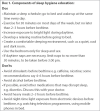Chronobiology and the case for sleep health interventions in the community
- PMID: 34409473
- PMCID: PMC8801860
- DOI: 10.11622/smedj.2021058
Chronobiology and the case for sleep health interventions in the community
Abstract
Our sleep-wake cycle is determined by the interaction between our homeostatic sleep drive and circadian rhythm. Each of us has a personalised biological rhythm or chronotype that determines the optimal time to fall asleep and wake up. Chronic sleep deprivation has been linked to the development of several physical and mental health disorders, as well as accidents and occupational errors. Around the world, growing recognition of the importance of sleep has led to the adoption of practices that promote sleep health. Given that Singaporeans were consistently found to be one of the most sleep-deprived populations in the world, we believe that there is an urgent need to pursue the introduction of community-based sleep health interventions here. This includes sleep education and promotion of sleep hygiene, adopting practices to reduce social jetlag and improve sleep health, and enhancing screening and treatment of sleep disorders.
Keywords: chronobiology; circadian rhythm; sleep deprivation; sleep health; sleep hygiene.
Copyright: © Singapore Medical Association.
Figures
References
-
- Borbély AA. A two process model of sleep regulation. Hum Neurobiol. 1982;1:195–204. - PubMed
-
- Borbély AA, Daan S, Wirz-Justice A, Deboer T. The two-process model of sleep regulation:a reappraisal. J Sleep Res. 2016;25:131–43. - PubMed
-
- Aschoff J. Exogenous and endogenous components in circadian rhythms. Cold Spring Harb Symp Quant Biol. 1960;25:11–28. - PubMed
MeSH terms
LinkOut - more resources
Full Text Sources
Medical


